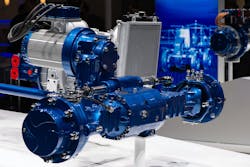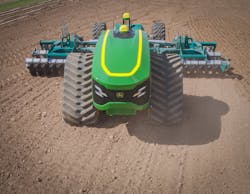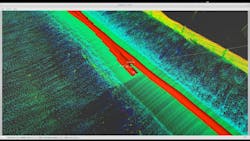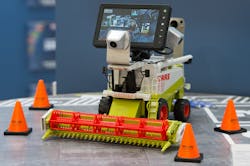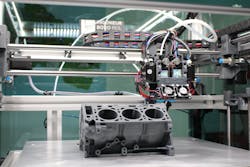Trends Impacting Agricultural Equipment Component and System Designs
There are several trends influencing the design of components and systems used within agricultural equipment. Like many other heavy equipment industries, the implementation of electrification and automation is bringing about the need for new technologies.
The agricultural equipment sector is the second largest customer market for the fluid power industry. Hydraulics in particular play an important role in tractors and other agriculture machinery – powering attachments, drive systems and more – and are therefore greatly impacted by these trends.
During a preview event for the Systems & Components portion of Agritechnica 2023 – one of the largest international events for the agriculture industry – the various market trends impacting the design of hydraulics and other components for agricultural equipment were outlined.
Agritechnica Systems & ComponentsThe Systems & Components portion of Agritechnica, taking place November 12-18, 2023, provides a space where suppliers of hydraulics, electronics and other components for agricultural equipment can exhibit their latest technologies.
Over 800 exhibitors are currently booked and take over three halls at the Hanover Exhibition Center. Green Productivity is the theme for this year’s event as suppliers and their customers are looking to not only improve their environmental footprint but also be more productive and efficient with their work.
Top Trends Influencing Component and System Designs
According to Prof. Dr.-Ing. Till Meinel, the broad spectrum of exhibitors and their solutions at Systems & Components demonstrate the key trends influencing the agricultural equipment industry which include:
- alternative drive technologies
- autonomous working
- new production techniques.
A Transition Away from Fossil Fuels
A range of alternative drive solutions are currently under development for the agricultural equipment industry to reduce carbon emissions. Several fuel options are available and growing in use, such as natural gas, methane and hydrogen.
Electrification is growing in this industry as well, and several approaches are available in the market today said Dr. Meinel during the Systems & Components preview event. When transitioning to an electric powertrain, he said it is important to understand that it is not as simple as switching from an internal combustion engine to an electric motor.
“Electrification of the whole drivetrain [requires] redeveloping a tractor or other self-propelled machine from scratch as you need electric motors and inverters, gearboxes, batteries, different hydraulic systems, and so on,” he said. “And everything has to be combined with new software and interact with multiple accessories.”
Similar to other off-highway equipment, smaller machines are currently where battery-electric systems are most feasible because of the energy density available with today’s batteries. Agricultural equipment with higher power needs and longer operating times will require larger, more powerful batteries but in many cases those currently available would add too much weight. Hybrid systems could be the medium-term solution until battery technology or another solution, such as fuel cells, is capable of meeting the power demands of larger machines.
READ MORE: Construction Equipment Digs Deeper into Electrification
Dr. Meinel said implementation of additional emissions regulations around the world has the potential further push the agricultural and other heavy equipment industries toward electrification and other alternative drive solutions. At Agritechnica and within the Systems & Components halls many of these will be on display, including battery- and fuel cell-powered concept machines.
“They set clear signs for a market shift toward zero emissions,” he said. “Commercially available machines are on the rise due to a close interaction between component manufacturers and OEMs.”
Dr. Meinel also noted electrification is taking the form of electronic components being used in place of traditional ones, such as hydraulics, to improve the efficiency of machines which can benefit emissions reduction efforts. Use of electronics can enable more precisely controlled machine functions or even a power boost in some machine designs.
In a pre-show press release, DLG – a German agricultural association and organizer of Agritechnica – gave the example of John Deere’s eAutoPowr stepless gearbox which replaces hydraulics with electronic components. The gearbox electrically drives a machine’s axles, allowing for precise speed regulation and improved acceleration.
While use of electronic options in place of hydraulics is increasing, there remain many instances in which hydraulics are the best option for an application; there are also many opportunities for advancements in hydraulic system designs to meet the requirements of electrification and other trends, which will benefit the fluid power industry.
The hydraulics section remains a large one within Systems & Components, signifying the continued importance of these systems in agricultural equipment.
READ MORE: Design Considerations for Electrification and Fluid Power
Smart Sensors and Sensor Fusion Enabling Autonomy
Agriculture is one of the heavy equipment industries which has been quicker to adopt various smart technologies, such as intelligent sensors and GPS navigation, due to the productivity gains which can be achieved.
This sector is also increasing its adoption of automation; auto steering has already been in use for several years. Now advancements in technology, as well as the need to overcome labor challenges and increase productivity, are enabling higher levels of automation to be employed.
Dr. Meinel said smart sensors and sensor fusion are helping to pave the way for autonomous machines in the off-highway equipment industry. “Sensor fusion optimally combines the measurements from multiple sensors, providing higher quality than any single sensor can do alone,” he explained. “This approach is already being employed in driver assistance systems and autonomous driving for on-road vehicles where fault tolerance and accuracy are a must.
READ MORE: Perception Systems Guide the Path to a Fully Autonomous Tractor
“While it's still a relatively new field in agriculture and the off-highway sector, sensor fusion is expected to quickly make inroads into mobile off-highway equipment such as excavators, bulldozers and tractors,” he added.
Sensor fusion algorithms can combine and compare the measurements taken by different sensors to provide more reliable recommendations. In agriculture, this can be used to determine the state of a crop in the field or enable field mapping. For autonomy, sensor fusion can help to provide better visibility around a machine or the working environment by allowing for better detection of obstacles, people or other objects.
To enable sensor fusion, sensors themselves need to be capable of capturing an array of information – which many today are. In addition, they must be able to withstand the harsh operating conditions in which agricultural and other off-highway equipment operate. Dr. Meinel said sensors must be capable of dealing with measurement noise which can be caused by vibrations, leading to errors in angle, position or other measurements.
Many sensor manufacturers, including those who will display their products at Agritechnica, are working to ensure their designs can perform as desired and withstand the rigors of off-road environments. Dr. Meinel said measurement systems which utilize a gyroscope to correct inclination sensors is one of the ways manufacturers can overcome the potential issues caused by vibration.
Advancements in sensor designs and sensor fusion will aid with the further progression of autonomous systems in agriculture and other off-highway equipment. The ultimate goal for many is to enable fully autonomous operation of machines. It will take time yet to reach that point, but incremental levels of autonomy are being achieved.
READ MORE: The 5 Levels of Autonomy in Off-Highway Equipment
Technology has evolved though to a point where mobile robots can be used in some farming applications. These fully autonomous machines are compact in size and can be remotely monitored and controlled, and are suited for tasks such as spraying or harvesting of delicate crops. Because there is no operator on these machines, and their use cases are specialized – often conducting a single, otherwise labor-intensive task – there are fewer safety issues to take into consideration which has eased their development compared to larger machines.
3D Printing and Other New Production Techniques
The use of additive manufacturing (AM), also referred to as 3D printing, by OEMs and suppliers is growing in the off-highway equipment industry as well. Dr. Meinel said many are using it for prototype and small batch production, as well as some who have fully integrated 3D printing into mass production operations.
Customization, adaptability, small production quantities and a high degree of freedom in shape and form are some of the benefits 3D printing offers. “Additive manufacturing can drastically shorten development times and produce high complex component geometries cost efficiently,” he said.
Dr. Meinel went on to say that at Systems & Components, several companies will show how 3D printing has evolved beyond rapid prototyping to enabling larger production quantities which can help improve the industrial value chain. A range of materials can now be used, helping expand the applicability of 3D printing.
Binder jetting is one of the 3D printing technologies becoming more widely available for rapid production of parts. Aidro Hydraulics & 3D Printing – which has used 3D printing for hydraulic and pneumatic components for several years now – recently received certification for its metal binder jetting capabilities. The company’s CEO Valeria Tirelli told Power & Motion during a discussion at IFPE 2023 that Aidro’s use of this technology will enable higher volume production of fluid power components.
“There's a wide range of 3D printing applications on the rise,” said Dr. Meinel. “3D printing has the potential to [benefit] maintenance – no warehouses, no storing boxes, no logistics. If you need the spare part, just print it.”
In addition, lighter weight components can be created as less material is used for the final part. This is helps to reduce overall machine weight, and thus energy use and emissions. The ability to create lighter weight components will also benefit electric-powered machines as offsetting the weight of batteries is necessary in many applications.
READ MORE: Additive Manufacturing Brings Opportunities to Improve Component Design and Production
Dr. Meinel concluded by saying Systems & Components 2023, and the entire Agritechnica event, will demonstrate these and other trends which are impacting designs within the agricultural equipment market – and the entire off-highway machinery sector. Innovative solutions to meet these trends will be on display throughout the show and from every type of manufacturer and supplier, including those from the fluid power industry.
About the Author
Sara Jensen
Executive Editor, Power & Motion
Sara Jensen is executive editor of Power & Motion, directing expanded coverage into the modern fluid power space, as well as mechatronic and smart technologies. She has over 15 years of publishing experience. Prior to Power & Motion she spent 11 years with a trade publication for engineers of heavy-duty equipment, the last 3 of which were as the editor and brand lead. Over the course of her time in the B2B industry, Sara has gained an extensive knowledge of various heavy-duty equipment industries — including construction, agriculture, mining and on-road trucks —along with the systems and market trends which impact them such as fluid power and electronic motion control technologies.
You can follow Sara and Power & Motion via the following social media handles:
X (formerly Twitter): @TechnlgyEditor and @PowerMotionTech
LinkedIn: @SaraJensen and @Power&Motion
Facebook: @PowerMotionTech

Leaders relevant to this article:

